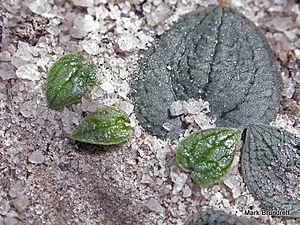Lonely hammer orchid facts for kids
Quick facts for kids Lonely hammer orchid |
|
|---|---|
 |
|
| Immature and mature leaves of Drakaea isolata | |
| Conservation status | |
| Scientific classification | |
| Genus: |
Drakaea
|
| Species: |
isolata
|
The lonely hammer orchid (Drakaea isolata) is a special type of orchid. It grows only in the south-west part of Western Australia. This orchid has a very clever way to get pollinated. It tricks a male wasp into helping it!
The orchid's special petal, called a labellum, looks and smells like a female wasp that cannot fly. The male wasp tries to mate with the flower, and in doing so, it helps the orchid spread its pollen. This amazing trick is called sexual deception.
This orchid is very rare. It is found in only one small area. Because of this, the Australian government has listed it as "endangered." The government of Western Australia calls it "threatened." This means it is in danger of disappearing forever. The first time scientists found this orchid was in 1984.
Contents
What the Lonely Hammer Orchid Looks Like
The lonely hammer orchid is similar to other hammer orchids. It has one leaf that lies flat on the ground. It also has an underground tuber, which is like a storage root.
The leaf is shaped like a heart. It is about 12 mm (half an inch) wide. Often, the leaf has dried up by the time the flower opens. The leaf is blue-grey and has tiny bumps or short hairs. Dark lines spread out from where the leaf joins the stem.
The stem of the orchid is about 10 to 30 cm (4 to 12 inches) tall. Each plant usually has only one flower. The stalk that holds the flower is about 10 to 15 mm long.
The Flower's Special Design
The flower of the lonely hammer orchid also looks like other hammer orchids. Its labellum looks like a female wasp that cannot fly. But this orchid's flower has some unique features.
The part of the flower called the column is pointed. The labellum does not have an upturned end. The main part of the labellum has long hairs and a longer, narrow "neck."
The back sepal (a leaf-like part of the flower) is 8 to 12 mm long. The two side sepals are 6 to 8 mm long. The petals are also 6 to 8 mm long.
The insect-like labellum has a "head" part. This "head" is about one-third the length of the "body" part. It has two dark bumps near its base. The rest of the labellum, which looks like the female wasp's "body," is dark maroon. It is smooth and not swollen like some other hammer orchids.
This flower is similar to the late hammer orchid (Drakaea confluens). However, the lonely hammer orchid's flower is smaller. It also has a more even color. These orchids bloom from September to mid-October.
How It Got Its Name
Scientists Stephen Hopper and Andrew Brown officially described Drakaea isolata in 2007. They published their description in a science journal called Australian Systematic Botany.
The second part of its scientific name, isolata, comes from a Latin word. It means "isolated." This name was chosen because this hammer orchid is found far away from other types of Drakaea orchids. It truly is a "lonely" orchid.
Where the Lonely Hammer Orchid Lives
The lonely hammer orchid grows near a town called Pingrup in Western Australia. This area is known as the Mallee region. It likes to grow in sandy soil close to a salt lake.
Protecting This Special Orchid
The Western Australian government's Department of Parks and Wildlife calls the lonely hammer orchid "threatened." This means it is likely to become extinct, or it is very rare and needs special care.
In 2003, scientists estimated there were only about 75 adult plants. There were also some younger plants. The Australian government lists it as "endangered" under its environmental protection laws.
There are several things that threaten this orchid's survival:
- Road and track maintenance: Work on roads can damage its habitat.
- Airborne dust: Dust from nearby activities can harm the plants.
- Changes to groundwater levels: If the water underground changes, the orchid might not get enough water.
- Inappropriate fire regimes: Fires that happen too often or not often enough can hurt the plants.
Protecting this unique orchid is very important so it does not disappear.


